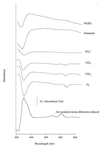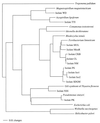Ubiquity and diversity of dissimilatory (per)chlorate-reducing bacteria
- PMID: 10583970
- PMCID: PMC91710
- DOI: 10.1128/AEM.65.12.5234-5241.1999
Ubiquity and diversity of dissimilatory (per)chlorate-reducing bacteria
Abstract
Environmental contamination with compounds containing oxyanions of chlorine, such as perchlorate or chlorate [(per)chlorate] or chlorine dioxide, has been a constantly growing problem over the last 100 years. Although the fact that microbes reduce these compounds has been recognized for more than 50 years, only six organisms which can obtain energy for growth by this metabolic process have been described. As part of a study to investigate the diversity and ubiquity of microorganisms involved in the microbial reduction of (per)chlorate, we enumerated the (per)chlorate-reducing bacteria (ClRB) in very diverse environments, including pristine and hydrocarbon-contaminated soils, aquatic sediments, paper mill waste sludges, and farm animal waste lagoons. In all of the environments tested, the acetate-oxidizing ClRB represented a significant population, whose size ranged from 2.31 x 10(3) to 2.4 x 10(6) cells per g of sample. In addition, we isolated 13 ClRB from these environments. All of these organisms could grow anaerobically by coupling complete oxidation of acetate to reduction of (per)chlorate. Chloride was the sole end product of this reductive metabolism. All of the isolates could also use oxygen as a sole electron acceptor, and most, but not all, could use nitrate. The alternative electron donors included simple volatile fatty acids, such as propionate, butyrate, or valerate, as well as simple organic acids, such as lactate or pyruvate. Oxidized-minus-reduced difference spectra of washed whole-cell suspensions of the isolates had absorbance maxima close to 425, 525, and 550 nm, which are characteristic of type c cytochromes. In addition, washed cell suspensions of all of the ClRB isolates could dismutate chlorite, an intermediate in the reductive metabolism of (per)chlorate, into chloride and molecular oxygen. Chlorite dismutation was a result of the activity of a single enzyme which in pure form had a specific activity of approximately 1,928 micromol of chlorite per mg of protein per min. Analyses of the 16S ribosomal DNA sequences of the organisms indicated that they all belonged to the alpha, beta, or gamma subclass of the Proteobacteria. Several were closely related to members of previously described genera that are not recognized for the ability to reduce (per)chlorate, such as the genera Pseudomonas and Azospirllum. However, many were not closely related to any previously described organism and represented new genera within the Proteobacteria. The results of this study significantly increase the limited number of microbial isolates that are known to be capable of dissimilatory (per)chlorate reduction and demonstrate the hitherto unrecognized phylogenetic diversity and ubiquity of the microorganisms that exhibit this type of metabolism.
Figures




References
-
- Agaev R, Danilov V, Khachaturov V, Kasymov B, Tishabaev B. The toxicity to warm-blooded animals and fish of new defoliants based on sodium and magnesium chlorates. Uzb Biol Zh. 1986;1:40–43.
-
- Bergnor E, Germgard U, Kolar J, Lindgren O. Formation of chlorate in chlorine dioxide bleaching. Cellul Chem Technol. 1987;21:307–314.
-
- Bruce R A, Achenbach L A, Coates J D. Dechlorimonas agitatus strain CKB gen. nov., sp. nov., a novel dissimilatory chlorate-reducer from a paper mill. Environ Microbiol. 1999;1:319–331. - PubMed
Publication types
MeSH terms
Substances
Associated data
- Actions
- Actions
- Actions
- Actions
- Actions
- Actions
- Actions
- Actions
- Actions
- Actions
- Actions
- Actions
LinkOut - more resources
Full Text Sources
Other Literature Sources
Molecular Biology Databases
Research Materials

